How to choose a soldering station
 An ordinary copper soldering iron soldering iron is not very suitable for soldering modern miniature circuit boards with SMD mounting. You can use it, unless, for soldering household appliances and printed circuit boards with output components, as they say, from case to case.
An ordinary copper soldering iron soldering iron is not very suitable for soldering modern miniature circuit boards with SMD mounting. You can use it, unless, for soldering household appliances and printed circuit boards with output components, as they say, from case to case.
For the installation and repair of modern electronics, soldering stations are increasingly being used, which have gained great popularity both among professional electronic engineers and amateur radio enthusiasts. This article gives a brief overview of soldering stations, which will undoubtedly help to solve the question of which station is better to purchase.
The miniaturization of electronic components and the appearance of multi-pin microcircuits made it impossible to solder the microcircuit with a conventional soldering iron. Some microcircuits do not have conclusions in the classical sense, for example, microcircuits in BGA packages ...
How to Irradiate a Soldering Iron Tip
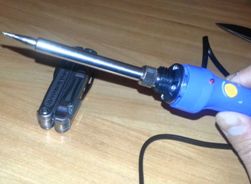 Fireproof soldering iron tips require a delicate attitude. In no case can they be cleaned with files or sandpaper, since the protective layer is quite thin, and its damage will lead to an early burnout and wear of the tip. Such stings can only be periodically wiped on a special sponge (sold with other soldering accessories), or on a wet piece of cloth.
Fireproof soldering iron tips require a delicate attitude. In no case can they be cleaned with files or sandpaper, since the protective layer is quite thin, and its damage will lead to an early burnout and wear of the tip. Such stings can only be periodically wiped on a special sponge (sold with other soldering accessories), or on a wet piece of cloth.
Instead of a special sponge, a dishwashing sponge is quite suitable. Naturally, the sponge should be moistened with water. You can moisten the sponge with glycerin (sold in pharmacies), then the sponge will not dry, always remain wet and ready to work.
To clean a non-combustible tip, among other soldering accessories, special tip cleaners are available. This is such a net, not to say a washcloth, made of brass chips in the shape of a ball, into which the sting should be periodically immersed. In this case, excess solder and oxides remain inside the coil...
Electric soldering irons: types and designs
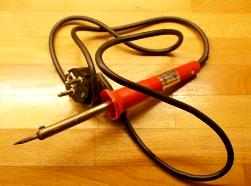 Modern electronic technology is improving very quickly. The degree of integration of modern microcircuits is such that millions of transistors fit in a single case, but the cases themselves are becoming smaller and smaller. Discrete parts - transistors, capacitors, resistors are also small-sized, lead-free. All this is mounted on boards by SMD surface mounting. The parts are so tightly arranged that it is simply impossible to solder something with an ordinary forty-watt EPSN electric soldering iron.
Modern electronic technology is improving very quickly. The degree of integration of modern microcircuits is such that millions of transistors fit in a single case, but the cases themselves are becoming smaller and smaller. Discrete parts - transistors, capacitors, resistors are also small-sized, lead-free. All this is mounted on boards by SMD surface mounting. The parts are so tightly arranged that it is simply impossible to solder something with an ordinary forty-watt EPSN electric soldering iron.
True, some experts from the soldering iron claim that you can solder anything you want even with an ax. Maybe this is so, but, as they say, not everyone is given. Therefore, it is better, nevertheless, to use a soldering iron, since now there is a very wide selection of soldering tools. And you need to be creative in purchasing this tool. First of all, it is necessary to determine for what work an electric soldering iron is bought ...
Soldering irons and soldering stations
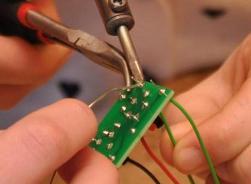 Soldering is the process of joining parts by introducing molten material between them - solder, the temperature of which, as a rule, is lower than the melting temperature of the parts to be joined. The purpose of soldering is to obtain a mechanical connection or electrical contact. Further, the article will mainly deal with the soldering of electronic components.
Soldering is the process of joining parts by introducing molten material between them - solder, the temperature of which, as a rule, is lower than the melting temperature of the parts to be joined. The purpose of soldering is to obtain a mechanical connection or electrical contact. Further, the article will mainly deal with the soldering of electronic components.
The soldering of metals was used in ancient times. It is believed that this technological operation has existed for at least 5000 years. Even when humanity did not know iron and steel, copper, gold and their alloys became widespread. But even then, master chasers used the connection of parts of products using soldering. Archaeologists have found gold vessels, the handles of which were soldered with gold, as well as alloys of gold and silver.Gold items with traces of soldering were found during excavations of the tombs of the ancient state of Babylon. Scientists dated finds 3200 BC ...
Good and bad LED wiring patterns
 In previous articles, various issues related to connecting LEDs were described. But you cannot write everything in one article, so you have to continue this topic. Here we will talk about various ways to turn on the LEDs.
In previous articles, various issues related to connecting LEDs were described. But you cannot write everything in one article, so you have to continue this topic. Here we will talk about various ways to turn on the LEDs.
The Chinese industry produces all kinds of souvenirs, trinkets, lighters, in which the LED is turned on without a limiting resistor: just two or three disk batteries and one LED. In this case, the current is limited by the internal resistance of the battery, the power of which is simply not enough to burn the LED.
But here, in addition to burnout, there is another unpleasant property - degradation of LEDs, most inherent in white and blue LEDs: after a while, the brightness of the glow becomes very small, although the current through the LED flows quite enough, at the nominal level. This is not to say that it does not shine at all ...
How to connect the LED to the lighting network
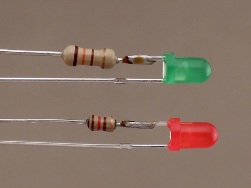 After reading this headline, someone might ask, “Why?” Yes, if you simply plug the LED into a power outlet, even turning it on in a certain pattern, it does not have practical value, it will not bring any useful information.
After reading this headline, someone might ask, “Why?” Yes, if you simply plug the LED into a power outlet, even turning it on in a certain pattern, it does not have practical value, it will not bring any useful information.
But if you connect the same LED in parallel with a heating element controlled by a temperature regulator, you can visually control the operation of the entire device. Sometimes this indication allows you to get rid of many small problems and troubles.
In the light of what has already been said about the inclusion of LEDs in previous articles, the task seems trivial: just put the limiting resistor of the desired value, and the issue is resolved. But all this is good if you feed the LED with a rectified constant voltage: as the LED was connected in the forward direction, it remained ...
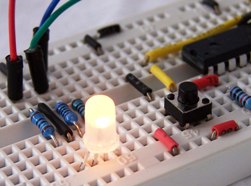 In some cases, for example, in flashlights or home lighting fixtures, it becomes necessary to adjust the brightness of the glow. It would seem that it’s easier: just change the current through the LED, increasing or decreasing the resistance of the limiting resistor. But in this case, a significant part of the energy will be spent on the limiting resistor, which is completely unacceptable with autonomous power supply from batteries or accumulators.
In some cases, for example, in flashlights or home lighting fixtures, it becomes necessary to adjust the brightness of the glow. It would seem that it’s easier: just change the current through the LED, increasing or decreasing the resistance of the limiting resistor. But in this case, a significant part of the energy will be spent on the limiting resistor, which is completely unacceptable with autonomous power supply from batteries or accumulators.
In addition, the color of the LEDs will change: for example, white when the current is lower than the nominal (for most LEDs 20mA) will have a slightly greenish tint. Such a color change in some cases is completely useless.
Imagine that these LEDs illuminate the screen of a TV or computer monitor. In these cases, PWM control is applied (pulse width) ...
About using LEDs, LED device, how to light an LED
 Everyone is familiar with LEDs now: LED lights, LED lamps, ribbons, and much more. Thanks to the efforts of the developers, absolutely exotic devices appeared, for example, a nozzle on a water tap. Outwardly, it is a transparent plastic cylinder: cool water poured - a blue LED lights up inside the nozzle, it has become warmer - yellow has lit up, and even if the water is too hot, the nozzle turns red. The content of the internal filling is unknown, but the fact that LEDs are used as emitting elements is obvious.
Everyone is familiar with LEDs now: LED lights, LED lamps, ribbons, and much more. Thanks to the efforts of the developers, absolutely exotic devices appeared, for example, a nozzle on a water tap. Outwardly, it is a transparent plastic cylinder: cool water poured - a blue LED lights up inside the nozzle, it has become warmer - yellow has lit up, and even if the water is too hot, the nozzle turns red. The content of the internal filling is unknown, but the fact that LEDs are used as emitting elements is obvious.
The first LED was developed at the University of Illinois back in 1962. In 1990, bright, and later superbright LEDs were born.The LED itself is very similar to a conventional rectifier diode, only when a direct current passes through it, the semiconductor crystal begins to glow ...
